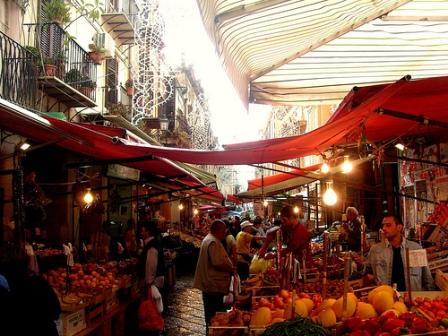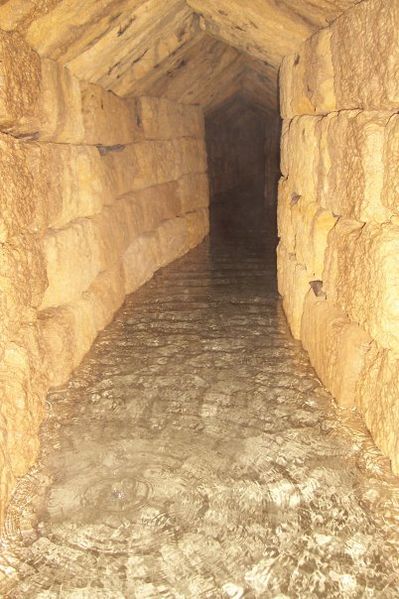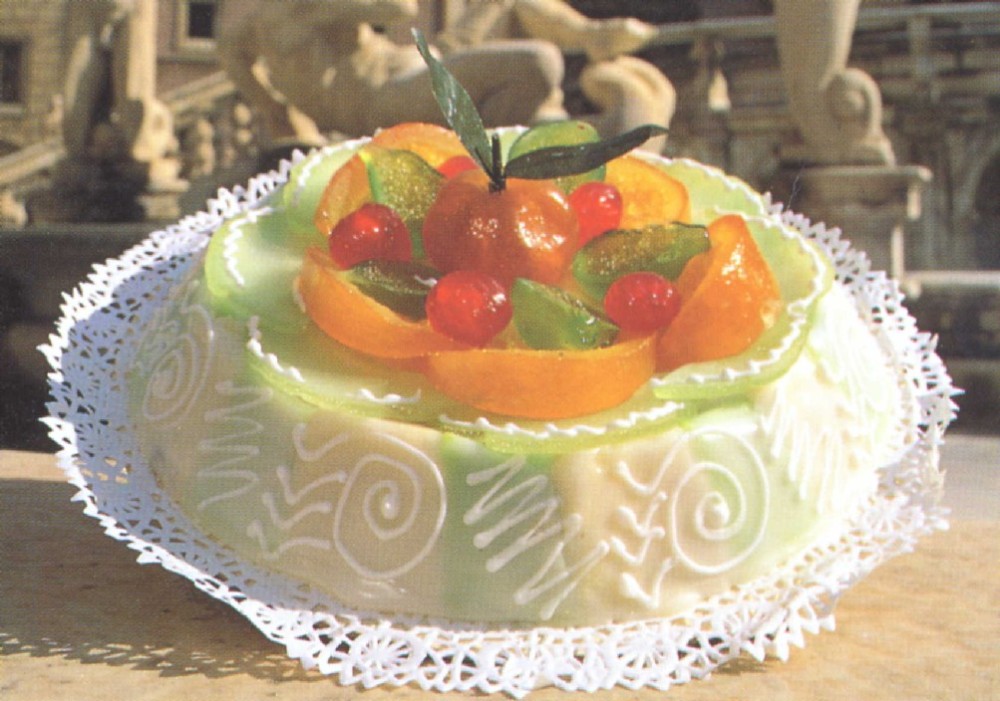Africans are so often portrayed as the underdogs, nowadays, that we sometimes forget they conquered southern Europe twice and ruled it for centuries.
The Sicilians don’t forget, though, for the Africans invented pasta as we know it, shaped their language and gave them the word Mafia, and brought them their citrus fruit trees, taught them to make dazzling coloured ceramics and founded street markets that still flourish like chaotic souks in central Palermo today.

The first wave of Africans were the Carthaginians. Carthage is now Tunis, in Tunisia. They spoke Phoenician, a Semitic language related to Hebrew, and were a cultural and ethnic mix of colonists from Lebanon and indigenous African Berbers. They never ruled Sicily without a fight, but first started founding cities here in the 8th century B.C. and always had a foothold on the island to the 2nd century B.C.
The Romans conquered Sicily eventually, and then later came a second wave of African invaders. By this time they were Muslim and they spoke Arabic, and the Europeans called them Moors. This is a vague term which applies to all the various races of northern Africa, including some sub-Saharan Africans as well. They ruled the Emirate of Sicily from 827 till 1061 A.D.
In Sicily, you see Africa all around you, even if you don’t recognise it.
COUS COUS: Cous cous is a Sicilian staple. In Sicily it is most often eaten with fish. The charming coastal town of San Vito Lo Capo has an annual cous cous festival in June, during which free cous cous is served in the streets for three days. There are also public cous cous making workshops (it’s a very fiddly, iterative process), a cooking tournament, and food markets. Oh yes, the Sicilians do like their food!
FACIAL GESTURES: If you ask a Sicilian a question, he may say nothing, but just tip his head back, look down his nose at you, and make a “tut” noise. English people do this to express disapproval, but when Sicilians do it, it just means “no”. Anyone who has travelled in the Middle East or North Africa will know that the Sicilians learned to do this from Arabic people.
Sicilians are generally the most hand-waving and emotional of all the Italians. A lot of their extremely tactile ways were picked up from the North Africans.
LANGUAGE: The Sicilian language is packed with Arabic words. They are too numerous to list. I’ll give you one, though…
THE WORD MAFIA: The Arabic word mahyas means “aggressive boasting or bragging.” This evolved into the Sicilian adjective mafiusu, which means arrogant, with a determination to dominate others through intimidation and bullying. And of course, people who have incorporated this behaviour into their way of life are the Mafia.
PASTA: I bet you didn’t know modern pasta was invented by Africans!
Records of pasta being eaten in Greece and Palestine go back to the 2nd century. It seems to have been widely eaten all around the Mediterranean in ancient times. They made it from flour and water, then boiled and ate it immediately. Italians still occasionally buy fresh pasta like this (pasta fresca) from small, local “pasta laboratories,” as they are amusingly called.
The Carthaginians introduced durum wheat to Sicily in the 8th century BC. It was soon being exported all around the Mediterranean. When the Moors came to Sicily, they realised durum wheat pasta can be dried hard. This makes it highly mould- and insect-resistant for long term storage and transportation. It was ideal for their export business and meant they could charge more for a value-added, ready-to-eat product. It also has the advantage of being ideal for toddlers’ art projects at kindergarten.
They opened large pasta factories in Sicily, particularly in Palermo and Trabia, to mass produce this dried pasta (pasta ascuitta), which is of course pasta as we now know it. In 1154, Mohammad Al-Idrisi wrote: “West of Termini there is a delightful settlement called Trabia. Its ever-flowing streams propel a number of mills. Here there are huge buildings in the countryside where they make vast quantities of itriyya [pasta] which is exported everywhere: to Calabria, to Muslim and Christian countries. Very many shiploads are sent.”
Pasta is still one of Sicily’s major exports. Have you seen Tomasello pasta in your supermarket? That’s made in Sicily, with production in several towns where the Africans first opened pasta factories over 1,000 years ago.

I have seen some claims that Marco Polo brought pasta to Italy, inspired by Chinese noodles. As you now know, this is blatant poppycock. Written records and archaeological evidence prove the Africans were mass-producing it in Sicily centuries before he was born.
CERAMICS: The Africans were experts in multi-coloured ceramic glazing techniques. They brought master craftsmen to establish potteries and train locals in Sicily. They replaced the ancient lead-oxide glazes with tin oxide glazes and added manganese purple and copper green to the color palette.
One of the typical ceramic artifacts they made looked like this, and people in Sicily still make them today:

Their techniques later spread throughout Italy and the style of pottery was named Maiolica. It is still a major craft in Sicily, especially in Caltagirone, the centre of the Moorish pottery industry in Sicily, and Santo Stefano di Camastra. These two small towns are packed with hundreds of ceramics shops in every street. My husband displays signs of intense panic when I ask him to take me to either of them.
“The kitchen walls are already full,” he protests. “We’ve got no more room.”
ARCHITECTURE: The legacy of the architecture brought over from Africa remains not only in the old buildings that still stand in Sicily, but in the architectural designs and buildings technology that worked their way all through Europe and even up to the medieval cathedral builders of Great Britain.
The baths at Cefala Diana, just south of Palermo, were built by the Moors and look like this:

They were constantly refilled with water from several natural springs. The spring water surged at various different temperatures, a different one for each of the pools.
Palermo Cathedral, which the Africans converted into a mosque, has some Arabic inscriptions on its exterior and examples of Islamic art.

The Normans who conquered Sicily so greatly admired Moorish architecture that they employed African architects, artists and craftsmen for their buildings. As a result, some of Palermo’s churches look like this:

And this:

The Castello di Zisa and La Cuba, also in Palermo, are in pure Fatimid style and surroundeded by Arabic gardens.
PALERMO AND ITS STREET MARKETS: The Carthaginians of Tunisia founded Palermo in 734 B.C. and gave it the catchy name of Zyz. Some of their city walls still survive in the city centre. Then in the 9th century A.D., the North African Moors invaded again, built new neighbourhoods, and filled the town with buzzing street markets that sold local foods and imported products.
Of these, the Capo and the Ballaro’ are still thriving markets with a real chaotic, souk-like vibe. Stall holders and customers alike wave their hands manically, shout their heads off and throw food and stuff all over the place. Your shoes will get wet gubbins on them. Don’t look too closely! It could be fish guts! I have a ridiculously high pair of pole-dancerish looking sandals which I wear for wading through the slurry when I go there to do my shopping.

You can buy fresh fruit and veg, spices, meat or sea food, and eat local delicacies such as a spleen sandwich or a small intestine kebab, freshly cooked in front of you. (When I say small, I mean it’s the small intestine. The kebab is fairly large. As I have already mentioned, Sicilians DO like their food.)
SURNAMES: Arabic surnames survive in Sicily. Salimbeni, Taibbi, Sacca’, Zappala’, Cuffaro and Micicchè are all derived from North African families. They often have the stress on the last vowel, which of course breaks all the rules of pronunciation in Italian.
There is also the name Fricano, which is extremely common in Bagheria where I live and in a few nearby towns. It is pretty easy to tell that this is derived from “African”, the name the Romans gave to Carthaginian Africans who remained in Sicily after the Romans conquered the island. Strangely, though, the Romans also gave this title to several generals of theirs as an honourary additional surname for conquering the Carthaginians in Africa.
CITRUS FRUIT: The North Africans brought citrus trees with them and planted them all over Sicily and particularly in the bay of Palermo, which came to be called the Bay of Gold because of the glowing fruit that filled it. Once the world discovered the cause of scurvy, selling citrus fruits to sailors from all over Europe made Palermo one of the richest cities in Europe.
The Sicilian word for orange blossom – zagara – derives from the Arabic word zahr. Sicilians make the zagara into a beautiful toilet-water type perfume, also invented by the North Africans.
IRRIGATION: The North Africans were experts in irrigation. They used a technique which was first employed to reclaim the deserts all over Persia (I’m deliberately not saying Iran, because Persia back in those days was much bigger), digging out gradually tilting tunnels under the whole bay of Palermo area and lining them with stone. The depth to which the channels were sunk and the subtle gradient gathered water from a wide area and made the Palermo bay into one of Europe’s most fertile farming areas.

These tunnels, called Qanats, are sometimes opened to members of the public who have an abnormally high level of resistance to claustrophobia. Before being turned into Sicily’s number one Terrifying Tourist Attraction, they were sometimes used as escape routes by the Mafia, who violently wrestled into ownership of the citrus industry in the 1980s (ruining its profitability), bought houses above the qanats’ entrances, and took control of the extensive network as a means of escaping the police.
PLACE NAMES: Sicily is full of towns with Arabic names. For example:
Marsala, where the wine comes from, is Mars’Allah meaning God’s Port;
Alcamo was founded by the Muslim General Al-Kamuk;
Mislimeri signifies the resting place of the Emir (Manzil-Al-Emir);
Caltagirone, Caltanisseta, Caltabellotta and Caltavuturo derive from the Arabic calta meaning castle;
Tommaso Natale, a place which means “Tommy Christmas,” has nothing to do with the Arabs; I presume it got its name simply because the Sicilians do sometimes just let their sense of humour get the better of them;
Mongibello, Gibilmanna and Gibellina’ stems are all in the mountainous, expressed in the Arabic word gibil;
Regalbuto, Racalmuto and Regaliali derive from rahl, meaning area or village;
Polizza Generosi is a charming mountain town which means “generous policy,” and also has nothing to do with the Arabic speaking Africans, yet I couldn’t resist including it. (It’s policy as in insurance policy. What happens if you crash your car there? Do they give you a new one plus a free motorbike as well?)
CAKES: The Arabs and North Africans sure do love their sugar! The Africans brought sugar cane to Sicily and cultivated it widely, including for export back to Africa. They built sugar refineries which stayed in business till the 17th century, when global sugar production moved over to the West Indies.
The Moors also incorporated it into a famous Sicilian ricotta cheese cake known as qashatah in Arabic, which means “cheesy” and which is now called cassata in modern Sicilian. It is so sugary and fatty that it contains 2,3456,876 calories per bite and is guaranteed to cause type 2 diabetes in under 24 hours or your money back. But look at it! How could you resist?

The other type of desert introduced by the Africans was little cakes made from ground nuts. They have no flour, just almond or pistachio flour, egg white and sugar. I’ve recently signed up to a ten-step programme to try to conquer my addiction to them.
CROPS: The Africans imported plants and established crops of almonds, aniseed, apricots, artichokes, cinnamon, oranges, pistachio, pomegranates, saffron, sesame, spinach, sugarcane, watermelon and rice to Sicily. Today, raisins and pine kernels are fundamental to lots of classic pasta and fish recipes.
They also brought in palm trees of all types: short fat pineapple-looking trees, middle sized bushy ones and gigantic date palms, everywhere, date palms! The dates don’t ripen in Sicily because (can this seriously be possible?) the climate isn’t hot enough. I wonder why they brought so many, given that fact. Was it hotter back then? The Sicilian Housewife swoons and chokes for air at the very thought of it. Maybe they were just trying to stave off homesickness. I am not complaining about the date palms, of course. They are beautiful, elegant and often provide an ideal shady patch just the right size to park your car in.
All in all, the Africans brought a great deal to Sicily. A lot of it worked its way up through Italy and spread out into Renaissance Europe.
I sometimes wonder how the modern world might look if the Carthaginians had won the power struggle in the Mediterranean, instead of the Romans. They started out as well-matched empires, so the struggle dragged on for several centuries and Rome only won by a whisker. If Carthage had won, maybe modern America would be populated by brown-skinned people speaking some modern dialect of Phoenician, that Semitic language similar to Hebrew.
*****
*****


The pizza was first invented in the 19th century. It has nothing to do with north African. Pasta pass to Italy through Greece. There are no records of pasta cooking presence in Africa. If you make some statement, you have to give your sources, thank you.
An Italian
LikeLike
The earliest known reference to pasta asciutta being produced commercially is in a geographical text of Muhammad al-Idrisi, compiled for the Norman King of Sicily Roger II in 1154. It mentions “itriyya” (dried pasta) manufactured and exported from Norman Sicily:
‘West of Termini there is a delightful settlement called Trabia. Its ever-flowing streams propel a number of mills. Here there are huge buildings in the countryside where they make vast quantities of itriyya which is exported everywhere: to Calabria, to Muslim and Christian countries. Very many shiploads are sent.’
You are correct that there is a 2nd century AD reference bynAthenaus of Naucratis probably to a sort of pasta made in Greece, however the text is ambiguous because it just talks of “mixing flour and water” and it certainly makes no reference to drying it for long term storage nor to making it in factories as an industry.
Regarding pizza, there are references to this in Virgil’s Aeneid from the 1st century and ultimately, you can argue all you like about when “modern pizza” was invented but pizza is basically cheese on a piece of bread and it’s existed in one form or another for as long as cheese and bread have.
LikeLike
She didn’t say pizza, she said pasta. And everyone knows that Italians were considered black. And in America the nig***s of Europeans. In the 1900’s they were not welcomed in America. And they had to change the last name to become a part of the working class. Just as many Jews had to americanize their names. I know this story from one person who is now 91 years old. Lives in my town. Told me the story what his dad had to do.
Written June 28, 2020
LikeLike
These are my sources.
I notice you don’t have any sources yourself.
LikeLike
Job well done. Thank you for the information.
LikeLiked by 1 person
United States is a country built on the concept of white supremacy.
Has the forceful containment of the Native indigenous population. when Europeans came they also had to contend with the white Anglo-Saxon Protestants. Each one has had to face some kind of prejudice and judgment. At the end of the day? All cultures are beautiful. But only the people who see beauty in themselves can appreciate the beauty around them.
LikeLike
Reblogged this on A Black Writer in Berlin and commented:
Interesting post.
LikeLike
Hi there, this is so interesting, mom is 93 and born there! Can’t wait to telll her ! She never told us any of it!Which tests will show most of my blood line! Books to read? Connie Giunta-Marcucci
LikeLike
What a delightful article! I don’t see the name of the writer but wish to thank them for writing it! It’s so beautifully written and informative and so witty and fun 🙂 My fathers side of the family has roots in Sicily and immigrated to New Orleans in the mid-1800’s. I loved reading the history of this place I wish to see one day.
LikeLiked by 1 person